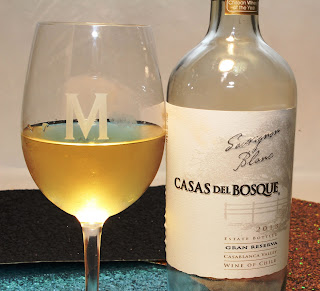“One of the
disadvantages of wine is that it makes a man mistake words for thoughts.”
- Samuel Johnson
- Samuel Johnson
I recall tasting a Zinfandel
aged in Gambia barrels. It was an interesting experience, mostly so because no
one at the dinner party could identify the varietal. Among other things, the wood had so changed
the natural character of the grape that identifying it was impossible without a
DNA kit. Was it a Petite Sirah? Yes, you would think so, but that’s not what
Zinfandel should taste like.
Delicious? Actually, it was. But
what’s the point? What other Zin could
you contrast this bottle against fairly?
It was not representative of the grape.
What it was was so unique as to become a variety of one.
 Maybe I need to be more open
minded. All wine is manipulated after all. Just tasting free run juice will
convince you how essential vinification is to the flavor of unvinified juice. But it
does seem that wine can be over manipulated and, in the process, lose its
varietal character, its natural essences. I have long felt that way about
Sauvignon Blanc. It’s naturally acidic
and fresh. A perfect summer refresher. Oaking it just seems wrong. Would you
oak Riesling? To quote a great New Yorker cartoon, “Is Nothing Sacred?” But
then I tasted an oaked version made by someone more famous for making Pinot
Noir in Sonoma than Sauvignon Blanc. It
worked. Very well. With that lesson under my belt, I was willing to try another;
ergo the Chilean Gran Reserva!
Maybe I need to be more open
minded. All wine is manipulated after all. Just tasting free run juice will
convince you how essential vinification is to the flavor of unvinified juice. But it
does seem that wine can be over manipulated and, in the process, lose its
varietal character, its natural essences. I have long felt that way about
Sauvignon Blanc. It’s naturally acidic
and fresh. A perfect summer refresher. Oaking it just seems wrong. Would you
oak Riesling? To quote a great New Yorker cartoon, “Is Nothing Sacred?” But
then I tasted an oaked version made by someone more famous for making Pinot
Noir in Sonoma than Sauvignon Blanc. It
worked. Very well. With that lesson under my belt, I was willing to try another;
ergo the Chilean Gran Reserva!
First thing to know is that
unlike Spain, Chile has no legal definition for applying the term “Grand
Reserva”. Affixing that term to the label is left to the discretion of the estate.
It may or may not be applied due to better barrels being used, or a selection
of superior grapes from their best vineyards being selected. But it is not associated with aging length.
The only requirement is that oak be used.
I also have to admit my
inherent preferences
(call them base-line prejudices). In Sauvignon Blanc, I
prefer Sancerre or Pouilly Fume. But I’ve had Sauvignon Blanc from New Zealand
(of course, it’s the law here), various states in the U.S., in white Bordeaux,
and others from South Africa, Australia and parts elsewhere. Despite this background, I wasn’t prepared at
all for this experience. A wine so totally
different, yet remaining true to the grape’s character. The grapefruit is
there, but not in the concentration of New Zealand's style. There was a cooked herbaceous quality to the
wine’s aroma (asparagus?) that cousined the green tint to the wine’s otherwise lemon
color. But the taste was lively; bright
even, though veiled through a sheeting of gun flint and quinine.
Somehow, fruit got through all
this: lime and honeysuckle. Some passionfruit. guava and kiwi, but again
veiled, this time through whispers of smoke. Not obstructive. Not intrusive.
Interesting. Throw in some gooseberry. If you can imagine this, you’ll understand
why I was intrigued. And somehow, the finish ends brightly on an acidic
freshness with salinity.
Grapes are from Casa del
Bosque’s own vineyards, about 70 kilometers (43.4 miles) from Santiago, the
capital of Chile, and from their vineyards in the coolest, westernmost reaches
of the Casablanca Valley. While my opinion, or that of anyone is not,
nor should be, a deciding factor, I’ll be buying more of this wine again just
to better appreciate the rendition. You
may have read Hamlet, and seen it acted a dozen times, even seen it on the
screen. But you’ll still pick up a nuance in a different production that makes
the experience new. That’s how I felt with this Sauvignon Blanc from Casa del
Bosque. Vinous awarded it 91 points;
Stephen Tanzer 91. And I? I plan to re-live the experience for the sheer interest
of it.
Salud!
…………………… Jim
Follow Wine Mizer on facebook for industry news, fun
facts, crossword puzzles and mini wine reviews – and great wine/food pairings
too!
TECH SPECS
Grapes were destemmed, crushed
to stainless via a chiller and kept at 4c/39f, then cold soaked 74 hours. Free
run juice then drained by gravity. Remaining skins and juice then pneumatic
pressed and left to cold settle at 10c/50f for 4 days. Following this, 26% was
racked to stainless and inoculated with selected yeasts and ultra-cool
fermented (6.5c/44f). After fermentation, this was aged 2 months on gross lees
(without stirring) before being blended. The remaining 74% was fermented with
selected yeasts in 2nd and 3rd use French oak with temps peaking at 22c/72f.
Post fermentation, the barrels were stirred weekly, after which (two months
later) the barrel and tank components were blended, cold stabilized and
filtered.
Variety : Sauvignon
Blanc, 64% clone 107, 36% clone 242.
Avg. Age of Vines 9 Yrs.
Soil Comp. Hillside, red clay
and decomposed granite
Alc: 14%
pH: 3.24
TA (Total Acidity): 6.3 g/L (grams per Liter)
RS (Residual Sugar): 2.2 g/L
Volatile Acidity 0.39
g/L
ARP: <$15.00 U.S.

No comments:
Post a Comment